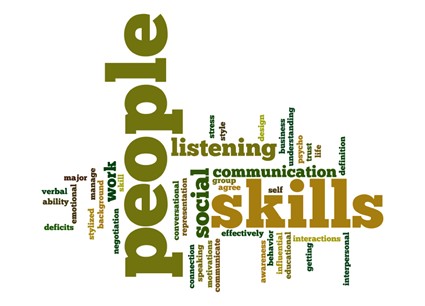The Advisor’s Corner – Are People Listening to Me?

Is it me, or are people listening less and less at work and at home?
StrategyDriven Response: (by Roxi Hewertson, StrategyDriven Principal Contributor)
I have observed a continuous degradation in communication skills among leaders for over two decades, and yes it IS getting worse. This may not surprise you, but it should get your attention. Poor communications skills are rampant in the workplace. We wag our fingers at politicians who are not listening to each other and yet, we are doing the same things in our own workplaces all around the country. The results may be less catastrophic (or not); never-the-less, the impact on our people, businesses and society is huge! While technology gets a lot of blame, I suggest that, like any tool, technology can be used in positive or negative ways. What really matters is HOW we CHOOSE to communicate, and use our tools.
Tools work well for:
- sharing information
- setting up meetings
- keeping a record
They do not work well:
- when we need to build a relationship, have a dialogue, or make a decision
- when we copy the world to cover our bases or boost our egos
- when there is emotion involved
A recent Development Dimensions International (DDI) study, Driving Workplace Performance through High-Quality Conversations: What leaders must do every day to be effective, accurately reflects my work with clients, and reminds us that leaders, peers and direct reports, need to hold more effective conversations to get more effective business performance. Since communication norms are deeply woven into the tapestry of every organization’s culture, this challenge starts with the CEO and involves all her/his leaders. The DDI study validates how important emotional intelligence competencies, particularly self-awareness and social skills are in human interactions.
Everything we do happens through our relationships – at work and in life. When communication is poor or stops, the relationship is poor or stops and vice versa. In the DDI study they point out that senior leaders have not mastered these (communication) skills any better than other less senior leaders, even though they have been at it longer. What happens instead? Take a few moments over the next several days to see if you notice any of these poor interaction habits in leaders you know, including yourself:
1. Jumping to task before understanding the full picture.
One Solution: Take time to gather information and listen carefully.
2. Unskilled at or choosing not to have, effective conversations.
One Solution: Learn this skill or get out of leadership.
3. Failing to engage others in decisions that impact them.
One Solution: Ask yourself, “Who is impacted by this decision?” and
engage them early on.
4. Failing to demonstrate authentic empathy.
One Solution: Slow down and truly put yourself in another person’s shoes. What might it be like to be them right now? Don’t know? Ask them.
5. Ego and personal agenda driven.
One Solution: Ask yourself, “Do I really need to be or prove I am right? Or do I want my team to succeed no matter whose idea it is?”
6. Unable to facilitate a productive meeting/discussion.
One Solution: Learn these skills and/or engage skilled facilitators to help you.
The systemic solution to improving interaction and communication skills in your organization, is to make it matter. It’s quite simple to do. What you reward, is what you will get. What you don’t reward, you will get much less often. Leaders generally know what a good conversation looks like.
Knowing is the easy part. Doing is the hard part. Since the leaders’ number one responsibility is to create and nurture the desired culture to get the desired results, every leader’s choices and priorities will roll downhill. This is particularly true for the behaviors we model to our direct reports – all the way from the C-Suite to the front line. At the end of the day, when we are not truly listening… we are not leading. Period.
Access the full report here, Driving Workplace Performance Through High-Quality Conversations: What leaders must do every day to be effective
About the Author

The StrategyDriven website was created to provide members of our community with insights to the actions that help create the shared vision, focus, and commitment needed to improve organizational alignment and accountability for the achievement of superior results. We look forward to answering your strategic planning and tactical business execution questions. Please email your questions to [email protected].

 In our global market place we are now conducting business with people we have not and may never meet. That means that now more than ever, being able to communicate in a clear and professional manner on the phone is critical to success in today’s business world. However, strong telephone communication is more complicated than many people realize. Experts say that up to 90% of communication is non-verbal. This means that talking on the telephone can be a particularly challenging communication task, since all of that non-verbal support is removed. However, there are ways you can compensate for the loss of that non-verbal communication and make sure you leave an impression each and every time you speak on the phone.
In our global market place we are now conducting business with people we have not and may never meet. That means that now more than ever, being able to communicate in a clear and professional manner on the phone is critical to success in today’s business world. However, strong telephone communication is more complicated than many people realize. Experts say that up to 90% of communication is non-verbal. This means that talking on the telephone can be a particularly challenging communication task, since all of that non-verbal support is removed. However, there are ways you can compensate for the loss of that non-verbal communication and make sure you leave an impression each and every time you speak on the phone. Jayne Latz is an expert in communication and CEO of Corporate Speech Solutions, LLC. She has worked as a speech trainer, coach, professional speaker, and has co-authored two books titled, Talking Business: A Guide to Professional Communication and Talking Business: When English is Your Second Language. She was recently featured in The Wall Street Journal and on The TODAY Show.
Jayne Latz is an expert in communication and CEO of Corporate Speech Solutions, LLC. She has worked as a speech trainer, coach, professional speaker, and has co-authored two books titled, Talking Business: A Guide to Professional Communication and Talking Business: When English is Your Second Language. She was recently featured in The Wall Street Journal and on The TODAY Show. Power Stars to Light the Business Flame, by Hank Moore, encompasses a full-scope business perspective, invaluable for the corporate and small business markets. It is a compendium book, containing quotes and extrapolations into business culture, arranged in 76 business categories.
Power Stars to Light the Business Flame, by Hank Moore, encompasses a full-scope business perspective, invaluable for the corporate and small business markets. It is a compendium book, containing quotes and extrapolations into business culture, arranged in 76 business categories.